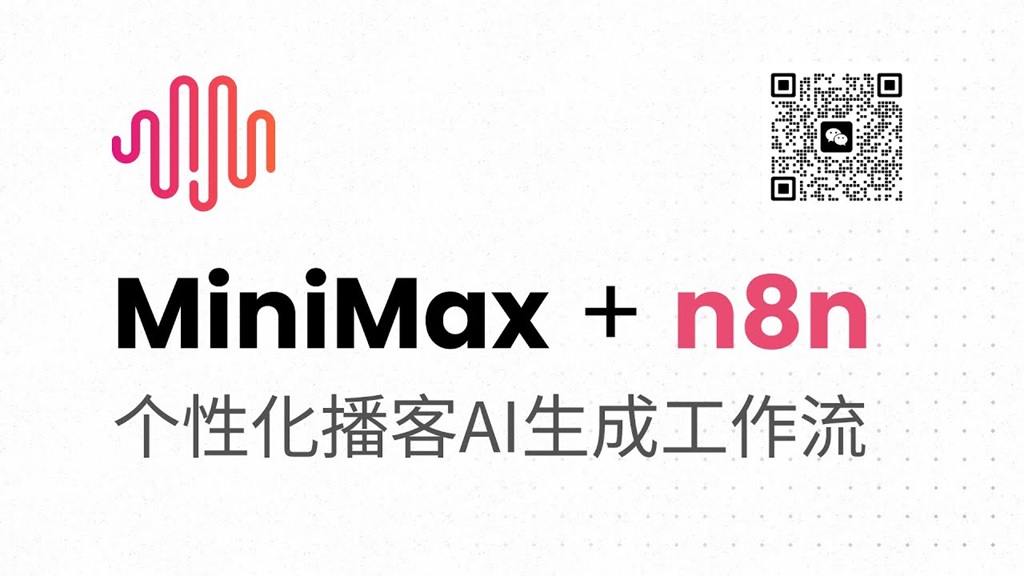
介绍
如何利用MiniMax的多模态AI服务结合n8n自动化工具,构建一个完整的个性化播客生成工作流。在AI技术快速发展的背景下,教程演示了如何将大语言模型、声音克隆技术和文字转语音功能有机结合,实现从话题输入到个性化播客音频输出的全自动化流程。
n8n与MiniMax集成完整安装配置指南
环境准备
系统要求
- Node.js: 18或更高版本
- 内存: 最少2GB RAM (推荐4GB)
- 存储: 最少10GB可用空间
- 网络: 稳定的互联网连接用于API调用
前置依赖
# Ubuntu/Debian系统
sudo apt update
sudo apt install curl wget git
# 安装Node.js 18+
curl -fsSL <https://deb.nodesource.com/setup_18.x> | sudo -E bash -
sudo apt install -y nodejs
# 验证安装
node --version
npm --version
n8n安装方法
方法1: 使用npm安装 (推荐本地开发)
# 全局安装n8n
npm install -g n8n
# 启动n8n
n8n start
# 或者使用npx临时运行 (无需安装)
npx n8n
访问 http://localhost:5678 开始使用n8n。
方法2: 使用Docker安装 (推荐生产环境)
# 创建数据卷
docker volume create n8n_data
# 运行n8n容器
docker run -it --rm \\
--name n8n \\
-p 5678:5678 \\
-v n8n_data:/home/node/.n8n \\
docker.n8n.io/n8nio/n8n
# 或者使用Docker Compose
docker-compose.yml文件:
version: '3.8'
services:
n8n:
image: docker.n8n.io/n8nio/n8n
restart: always
ports:
- "5678:5678"
environment:
- N8N_BASIC_AUTH_ACTIVE=true
- N8N_BASIC_AUTH_USER=admin
- N8N_BASIC_AUTH_PASSWORD=your_password
- N8N_HOST=localhost
- N8N_PORT=5678
- N8N_PROTOCOL=http
- NODE_ENV=production
volumes:
- n8n_data:/home/node/.n8n
volumes:
n8n_data:
# 启动Docker Compose
docker-compose up -d
方法3: VPS部署 (生产环境)
# 更新系统包
sudo apt update
# 安装Node.js
curl -fsSL <https://deb.nodesource.com/setup_18.x> | sudo -E bash -
sudo apt install -y nodejs
# 安装n8n
npm install -g n8n
# 安装PM2进程管理器
npm install -g pm2
# 安装Nginx反向代理
sudo apt install nginx
# 安装SSL证书工具
sudo apt install certbot python3-certbot-nginx
创建n8n启动脚本 /home/user/start-n8n.sh:
#!/bin/bash
export N8N_PORT=5678
export N8N_HOST=your-domain.com
export N8N_PROTOCOL=https
export WEBHOOK_URL=https://your-domain.com/
export N8N_BASIC_AUTH_ACTIVE=true
export N8N_BASIC_AUTH_USER=admin
export N8N_BASIC_AUTH_PASSWORD=your_secure_password
n8n start
# 使用PM2启动n8n
chmod +x /home/user/start-n8n.sh
pm2 start /home/user/start-n8n.sh --name n8n
pm2 save
pm2 startup # 设置开机自启动
Nginx配置 /etc/nginx/sites-available/n8n:
server {
listen 80;
server_name your-domain.com;
location / {
proxy_pass <http://localhost:5678>;
proxy_set_header Host $host;
proxy_set_header X-Real-IP $remote_addr;
proxy_set_header X-Forwarded-For $proxy_add_x_forwarded_for;
proxy_set_header X-Forwarded-Proto $scheme;
# WebSocket支持
proxy_http_version 1.1;
proxy_set_header Upgrade $http_upgrade;
proxy_set_header Connection 'upgrade';
proxy_cache_bypass $http_upgrade;
}
}
# 启用Nginx配置
sudo ln -s /etc/nginx/sites-available/n8n /etc/nginx/sites-enabled/
sudo nginx -t
sudo systemctl reload nginx
# 配置SSL证书
sudo certbot --nginx -d your-domain.com
MiniMax API准备
1. 获取API凭证
- 访问 MiniMax平台 并注册账户
- 登录后台,进入API管理页面
- 创建新的API密钥
- 记录以下信息:
- API Key: 用于API认证
- Group ID: 在个人资料中找到
- API Host:
- 全球用户:
https://api.minimaxi.chat - 中国用户:
https://api.minimax.chat
- 全球用户:
2. API限制和定价了解
- 日限制: 每个组织每24小时1,000次API调用
- 月限制: 每个组织每月20,000次API调用
- 文本转语音: $50 / 100万字符
- 视频生成: $0.43 / 视频
- 图像生成: $0.0035 / 图像
n8n基础配置
1. 初始化设置
- 打开浏览器访问n8n实例地址
- 首次访问会看到注册页面
- 创建管理员账户:
- 名字和姓氏
- 邮箱地址
- 安全密码
2. 基本安全配置
环境变量配置文件 .env:
# 基础认证
N8N_BASIC_AUTH_ACTIVE=true
N8N_BASIC_AUTH_USER=admin
N8N_BASIC_AUTH_PASSWORD=your_secure_password
# 域名和协议
N8N_HOST=your-domain.com
N8N_PROTOCOL=https
N8N_PORT=5678
# Webhook URL
WEBHOOK_URL=https://your-domain.com/
# 数据库配置 (可选,默认使用SQLite)
DB_TYPE=postgresdb
DB_POSTGRESDB_HOST=localhost
DB_POSTGRESDB_PORT=5432
DB_POSTGRESDB_DATABASE=n8n
DB_POSTGRESDB_USER=n8n_user
DB_POSTGRESDB_PASSWORD=n8n_password
# 时区设置
GENERIC_TIMEZONE=Asia/Shanghai
# 日志级别
N8N_LOG_LEVEL=info
3. 用户管理设置
# 启用用户管理
N8N_USER_MANAGEMENT_DISABLED=false
# JWT设置
N8N_USER_MANAGEMENT_JWT_SECRET=your_jwt_secret_key
# 邮件配置 (用于邀请用户)
N8N_EMAIL_MODE=smtp
N8N_SMTP_HOST=smtp.gmail.com
N8N_SMTP_PORT=587
N8N_SMTP_USER=your-email@gmail.com
N8N_SMTP_PASS=your-app-password
N8N_SMTP_SENDER=your-email@gmail.com
MiniMax凭证配置
1. 创建自定义凭证类型
由于n8n目前不支持MiniMax的预定义凭证类型,我们需要创建自定义凭证:
方法1: 使用Header Auth凭证
- 在n8n中点击 Credentials → Add Credential
- 搜索并选择 Header Auth
- 配置以下参数:
- Credential Name:
MiniMax API - Name:
Authorization - Value:
Bearer your_api_key_here
- Credential Name:
方法2: 创建自定义凭证类型
自定义凭证JSON配置:
{
"name": "miniMaxApi",
"displayName": "MiniMax API",
"documentationUrl": "<https://www.minimax.io/>",
"properties": [
{
"displayName": "API Key",
"name": "apiKey",
"type": "string",
"typeOptions": {
"password": true
},
"default": "",
"required": true
},
{
"displayName": "Group ID",
"name": "groupId",
"type": "string",
"default": "",
"required": true
},
{
"displayName": "API Host",
"name": "apiHost",
"type": "options",
"options": [
{
"name": "Global (api.minimaxi.chat)",
"value": "<https://api.minimaxi.chat>"
},
{
"name": "China (api.minimax.chat)",
"value": "<https://api.minimax.chat>"
}
],
"default": "<https://api.minimaxi.chat>",
"required": true
}
],
"authenticate": {
"type": "generic",
"properties": {
"headers": {
"Authorization": "Bearer {{$credentials.apiKey}}"
}
}
}
}
2. 配置HTTP Request节点凭证
- 添加 HTTP Request 节点到工作流
- 在节点配置中选择 Authentication → Predefined Credential Type 或 Generic Credential Type
- 选择之前创建的MiniMax凭证
工作流搭建
1. 基础播客生成工作流
节点1: Chat Trigger (聊天触发器)
{
"parameters": {},
"type": "n8n-nodes-base.chatTrigger",
"typeVersion": 1,
"position": [0, 0]
}
节点2: AI Agent (OpenAI + Serp API)
{
"parameters": {
"agent": "conversationalAgent",
"promptType": "define",
"text": "你是一个专业的播客内容生成助手。请根据用户输入的话题,使用搜索工具获取最新信息,并生成适合播客的内容。",
"hasOutputParser": true,
"options": {
"systemMessage": "请确保生成的内容准确、有趣、适合播客格式。"
}
},
"type": "@n8n/n8n-nodes-langchain.agent",
"typeVersion": 1,
"position": [200, 0]
}
节点3: Translator (内容翻译和重写)
{
"parameters": {
"model": "gpt-4",
"options": {
"systemMessage": "请将输入内容翻译为中文,并重写为适合播客录制的语料。要求:\\n1. 翻译为中文\\n2. 重写内容和措辞,使其适合播客阅读\\n3. 语料应该生活化,具备聊天特性\\n4. 禁止使用换行符、制表符等特殊符号\\n5. 只输出重写后的文字"
}
},
"type": "@n8n/n8n-nodes-langchain.openAi",
"typeVersion": 1,
"position": [400, 0]
}
节点4: List Voices (获取声音列表)
{
"parameters": {
"method": "POST",
"url": "={{$credentials.apiHost}}/v1/t2a_v2/voices",
"sendQuery": true,
"queryParameters": {
"parameters": [
{
"name": "GroupId",
"value": "={{$credentials.groupId}}"
}
]
},
"sendBody": true,
"bodyContentType": "json",
"jsonBody": "{\\n \\"voice_type\\": \\"all\\"\\n}",
"options": {}
},
"type": "n8n-nodes-base.httpRequest",
"typeVersion": 4,
"position": [600, 100],
"credentials": {
"httpHeaderAuth": {
"id": "minimax_credentials_id",
"name": "MiniMax API"
}
}
}
节点5: Text to Audio (文字转语音)
{
"parameters": {
"method": "POST",
"url": "={{$credentials.apiHost}}/v1/t2a_v2",
"sendQuery": true,
"queryParameters": {
"parameters": [
{
"name": "GroupId",
"value": "={{$credentials.groupId}}"
}
]
},
"sendBody": true,
"bodyContentType": "json",
"jsonBody": "{\\n \\"model\\": \\"speech-01-hd\\",\\n \\"text\\": \\"{{$node['Translator'].json['output'].replace(/\\\\n/g, ' ').replace(/\\\\t/g, ' ')}}\\",\\n \\"voice_id\\": \\"your_cloned_voice_id\\",\\n \\"output_format\\": \\"url\\",\\n \\"speed\\": 1.0,\\n \\"vol\\": 50,\\n \\"pitch\\": 0,\\n \\"timber\\": 0,\\n \\"emotion\\": \\"neutral\\"\\n}",
"options": {}
},
"type": "n8n-nodes-base.httpRequest",
"typeVersion": 4,
"position": [800, 0],
"credentials": {
"httpHeaderAuth": {
"id": "minimax_credentials_id",
"name": "MiniMax API"
}
}
}
节点6: Download Audio (下载音频文件)
{
"parameters": {
"method": "GET",
"url": "={{$node['Text to Audio'].json['audio_url']}}",
"options": {
"response": {
"response": {
"responseFormat": "file"
}
}
}
},
"type": "n8n-nodes-base.httpRequest",
"typeVersion": 4,
"position": [1000, 0]
}
2. 语音克隆工作流
语音克隆完整流程
{
"name": "MiniMax Voice Cloning Workflow",
"nodes": [
{
"parameters": {
"path": "voice-clone",
"method": "POST"
},
"type": "n8n-nodes-base.webhook",
"typeVersion": 1,
"position": [0, 0],
"name": "Webhook"
},
{
"parameters": {
"method": "POST",
"url": "={{$credentials.apiHost}}/v1/files/upload",
"sendQuery": true,
"queryParameters": {
"parameters": [
{
"name": "GroupId",
"value": "={{$credentials.groupId}}"
}
]
},
"sendBody": true,
"bodyContentType": "multipart-form-data",
"bodyParameters": {
"parameters": [
{
"name": "file",
"inputDataFieldName": "audio_file"
}
]
}
},
"type": "n8n-nodes-base.httpRequest",
"typeVersion": 4,
"position": [200, 0],
"name": "Upload Audio File",
"credentials": {
"httpHeaderAuth": {
"id": "minimax_credentials_id",
"name": "MiniMax API"
}
}
},
{
"parameters": {
"method": "POST",
"url": "={{$credentials.apiHost}}/v1/voice_clone",
"sendQuery": true,
"queryParameters": {
"parameters": [
{
"name": "GroupId",
"value": "={{$credentials.groupId}}"
}
]
},
"sendBody": true,
"bodyContentType": "json",
"jsonBody": "{\\n \\"file_id\\": \\"{{$node['Upload Audio File'].json['file_id']}}\\",\\n \\"voice_name\\": \\"{{$node['Webhook'].json['body']['voice_name']}}\\"\\n}"
},
"type": "n8n-nodes-base.httpRequest",
"typeVersion": 4,
"position": [400, 0],
"name": "Clone Voice",
"credentials": {
"httpHeaderAuth": {
"id": "minimax_credentials_id",
"name": "MiniMax API"
}
}
}
],
"connections": {
"Webhook": {
"main": [
[
{
"node": "Upload Audio File",
"type": "main",
"index": 0
}
]
]
},
"Upload Audio File": {
"main": [
[
{
"node": "Clone Voice",
"type": "main",
"index": 0
}
]
]
}
}
}
高级配置和最佳实践
1. 错误处理和重试机制
{
"parameters": {
"rules": {
"rules": [
{
"type": "expression",
"expression": "{{$node['HTTP Request'].json['error']}}",
"output": 1
}
]
},
"fallbackOutput": 0
},
"type": "n8n-nodes-base.switch",
"typeVersion": 1,
"position": [600, 0],
"name": "Error Check"
}
2. 日志记录节点
{
"parameters": {
"operation": "log",
"message": "=MiniMax API调用成功: {{$json}}",
"level": "info"
},
"type": "n8n-nodes-base.function",
"typeVersion": 1,
"position": [800, 0],
"name": "Log Success"
}
3. 数据验证和清理
// Function节点中的JavaScript代码
const inputText = $input.all()[0].json.text;
// 清理文本中的特殊字符
const cleanedText = inputText
.replace(/[\\n\\r\\t]/g, ' ') // 移除换行符和制表符
.replace(/\\s+/g, ' ') // 合并多个空格
.trim(); // 移除首尾空格
// 检查文本长度限制
if (cleanedText.length > 5000) {
throw new Error('文本长度超过5000字符限制');
}
return [{
json: {
cleanedText: cleanedText,
originalLength: inputText.length,
cleanedLength: cleanedText.length
}
}];
4. 批量处理优化
{
"parameters": {
"batchSize": 5,
"options": {
"reset": false
}
},
"type": "n8n-nodes-base.splitInBatches",
"typeVersion": 1,
"position": [400, 0],
"name": "Batch Processing"
}
常见问题解决
1. API认证错误
问题: Invalid API key 错误 解决方案:
- 检查API Host和API Key是否匹配区域
- 确认API Key格式正确,没有多余空格
- 验证Group ID是否正确
2. 网络连接问题
问题: 请求超时或连接失败 解决方案:
{
"parameters": {
"timeout": 30000,
"redirect": {
"redirect": {
"followRedirects": true,
"maxRedirects": 5
}
}
}
}
3. 内存不足问题
问题: n8n崩溃或性能问题 解决方案:
# 增加Node.js内存限制
export NODE_OPTIONS="--max-old-space-size=4096"
# 或者在启动时设置
node --max-old-space-size=4096 /usr/local/bin/n8n start
4. SSL证书问题
问题: HTTPS证书验证失败 解决方案:
{
"parameters": {
"options": {
"rejectUnauthorized": false
}
}
}
5. 字符编码问题
问题: 中文字符显示异常 解决方案:
# 设置环境变量
export LANG=zh_CN.UTF-8
export LC_ALL=zh_CN.UTF-8
6. 工作流执行限制
问题: 工作流执行时间过长 解决方案:
# 增加执行超时时间
export EXECUTIONS_TIMEOUT=3600
export EXECUTIONS_TIMEOUT_MAX=7200
监控和维护
1. 日志配置
# 设置详细日志级别
export N8N_LOG_LEVEL=debug
export N8N_LOG_OUTPUT=file,console
export N8N_LOG_FILE_LOCATION=/var/log/n8n/
2. 性能监控
# 使用PM2监控
pm2 monit
# 查看n8n进程状态
pm2 status n8n
# 查看日志
pm2 logs n8n
3. 备份策略
# 备份n8n数据
cp -r ~/.n8n/ ~/n8n-backup-$(date +%Y%m%d)/
# 备份数据库 (如果使用PostgreSQL)
pg_dump n8n > n8n-backup-$(date +%Y%m%d).sql
4. 更新维护
# 更新n8n
npm update -g n8n
# 重启服务
pm2 restart n8n
# 检查版本
n8n --version
通过以上完整的安装和配置指南,可以成功搭建n8n与MiniMax的集成环境,实现个性化播客AI生成工作流。记住要定期备份数据,监控系统性能,并保持软件更新以确保最佳性能和安全性。
MiniMax + n8n 视频
相关视频内容
MiniMax平台功能介绍 (00:01-02:11)
- 多模态服务:MiniMax提供文字转语音、文字转视频、文字转音乐、文字转图片等服务
- 声音克隆功能:用户可以上传10-60秒的语音文件或直接录制,完成个人声音的克隆
- 操作流程:注册登录 → Audio → Voices → Create voice clone → 上传/录制语音 → 命名 → 转换完成
n8n工作流构建 (03:14-09:37)
- 触发器节点:以聊天消息作为触发,用户输入感兴趣的话题
- AI代理节点:配置OpenAI GPT-4o模型,集成Serp API进行数据搜索和内容生成
- 翻译处理节点:将内容翻译为中文并重写为适合播客的语料风格
- 声音列表节点:通过MiniMax API获取可用声音列表
- 文字转语音节点:使用MiniMax TTS API和克隆的声音生成音频
- 文件下载节点:下载生成的MP3音频文件
技术细节和配置
- API集成:详细介绍了MiniMax API的调用方法和参数配置
- 数据处理:处理换行符等特殊字符,确保JSON格式正确
- 认证设置:在n8n中创建自定义凭证类型来支持MiniMax API
MiniMax AI平台与算法:Python实现与API示例
基于研究,以下提供一个关于MiniMax的全面指南,涵盖AI平台和算法两个方面:
MiniMax AI平台概述
MiniMax是一家中国AI公司,提供安全、灵活、可靠的API服务,其旗舰模型包括图像生成的Image-01、视频生成的T2V-01-Director、大语言模型MiniMax-Text-01,以及支持语音克隆的speech-01-hd。
Python集成方案
1. 安装和配置
# 方法1:非官方Python SDK(专注视频生成)
pip install minimax-python
# 方法2:官方MCP服务器
curl -LsSf <https://astral.sh/uv/install.sh> | sh
uvx minimax-mcp -y
# 方法3:直接API调用
pip install requests
2. 基础配置
import os
from minimax import Minimax
# 环境变量配置
os.environ["MINIMAX_API_KEY"] = "your_api_key_here"
os.environ["MINIMAX_GROUP_ID"] = "your_group_id_here"
# 直接初始化
client = Minimax(
api_key="your_api_key",
group_id="your_group_id"
)
# 重要:API主机因地区而异
# 全球主机:<https://api.minimaxi.chat>(注意额外的"i")
# 中国主机:<https://api.minimax.chat>
3. 文本转语音实现
import requests
import json
def text_to_speech(text, voice_id="default", api_key="your_api_key", group_id="your_group_id"):
"""使用MiniMax TTS API将文本转换为语音"""
url = f"<https://api.minimaxi.chat/v1/t2a_v2?GroupId={group_id}>"
headers = {
"Authorization": f"Bearer {api_key}",
"Content-Type": "application/json"
}
data = {
"model": "speech-01-hd",
"text": text,
"voice_id": voice_id,
"output_format": "mp3",
"speed": 1.0,
"vol": 50,
"pitch": 0,
"timber": 0,
"emotion": "happy" # 选项:happy, sad, angry, fearful, disgusted, surprised, neutral
}
response = requests.post(url, headers=headers, json=data)
if response.status_code == 200:
result = response.json()
return result.get("audio_url")
else:
print(f"错误: {response.status_code} - {response.text}")
return None
# 使用示例
audio_url = text_to_speech("你好,这是MiniMax文本转语音的测试!")
print(f"生成的音频URL: {audio_url}")
4. 语音克隆实现
def clone_and_use_voice(audio_file_path, voice_name, text_to_speak, api_key, group_id):
"""完整的语音克隆工作流程:上传音频、克隆声音、生成语音"""
# 步骤1:上传音频文件
print("正在上传音频文件...")
file_id = upload_audio_file(audio_file_path, api_key, group_id)
if not file_id:
return None
# 步骤2:克隆声音
print(f"正在克隆声音: {voice_name}")
voice_id = clone_voice(file_id, voice_name, api_key, group_id)
if not voice_id:
return None
# 步骤3:使用克隆的声音生成语音
print("正在使用克隆的声音生成语音...")
audio_url = text_to_speech(text_to_speak, voice_id, api_key, group_id)
return audio_url
# 使用示例
result_url = clone_and_use_voice(
"my_voice_sample.mp3",
"我的自定义声音",
"这是我克隆的声音在说话!",
"your_api_key",
"your_group_id"
)
5. 视频生成
from minimax import Minimax
def generate_video_example():
client = Minimax()
# 文本转视频
prompt = """一条威严的巨龙在夕阳染红的云层中翱翔,
它的鳞片闪烁着金色光芒。镜头平滑地跟随巨龙在紫橙色
天空背景下优雅的空中动作。"""
client.generate_video(
text=prompt,
download_path="dragon_video.mp4"
)
# 图像转视频,带提示引导
prompt = """图像中的巨龙苏醒了,眼中闪烁着古老的力量。
镜头缓缓环绕,巨龙展开翅膀,在迷雾缭绕的山间空气中
掀起阵阵涟漪。"""
client.generate_video(
image="dragon_image.jpg",
text=prompt,
download_path="dragon_awakening.mp4"
)
6. 大语言模型集成
# 使用LangChain集成
from langchain_community.llms import Minimax
from langchain.chains import LLMChain
from langchain_core.prompts import PromptTemplate
# 设置MiniMax与LangChain
llm = Minimax(
minimax_api_key="your_api_key",
minimax_group_id="your_group_id"
)
# 创建简单链
template = """问题: {question}
答案: 让我们一步步思考。"""
prompt = PromptTemplate.from_template(template)
chain = LLMChain(llm=llm, prompt=prompt)
# 使用示例
response = chain.run("pandas和NumPy的区别是什么?")
print(response)
Minimax算法实现
除了AI平台,我还提供了经典的minimax算法实现,用于游戏理论中的最优决策:
井字棋Minimax算法
import math
class TicTacToe:
def __init__(self):
self.board = [' ' for _ in range(9)]
def minimax(self, depth, is_maximizing_player, alpha=-math.inf, beta=math.inf):
"""带alpha-beta剪枝的Minimax算法"""
winner = self.check_winner()
# 终止状态
if winner == 'X':
return 1
elif winner == 'O':
return -1
elif winner == 'Tie':
return 0
if is_maximizing_player:
max_eval = -math.inf
for move in self.available_moves():
self.make_move(move, 'X')
eval_score = self.minimax(depth + 1, False, alpha, beta)
self.undo_move(move)
max_eval = max(max_eval, eval_score)
alpha = max(alpha, eval_score)
if beta <= alpha:
break # Alpha-beta剪枝
return max_eval
else:
min_eval = math.inf
for move in self.available_moves():
self.make_move(move, 'O')
eval_score = self.minimax(depth + 1, True, alpha, beta)
self.undo_move(move)
min_eval = min(min_eval, eval_score)
beta = min(beta, eval_score)
if beta <= alpha:
break # Alpha-beta剪枝
return min_eval
最佳实践
错误处理和重试机制
import time
import random
from functools import wraps
def retry_with_exponential_backoff(max_retries=3, base_delay=1):
"""实现指数退避重试逻辑的装饰器"""
def decorator(func):
@wraps(func)
def wrapper(*args, **kwargs):
for attempt in range(max_retries):
try:
return func(*args, **kwargs)
except Exception as e:
if attempt == max_retries - 1:
raise e
delay = base_delay * (2 ** attempt) + random.uniform(0, 1)
print(f"第{attempt + 1}次尝试失败: {e}. {delay:.2f}秒后重试...")
time.sleep(delay)
return None
return wrapper
return decorator
总结
这个全面的指南涵盖了:
- MiniMax AI平台:提供安全、灵活、可靠的API服务,支持超过40,000家企业客户
- 多模态能力:文本转语音、语音克隆、视频生成、图像生成、大语言模型
- Python集成:多种集成方式,包括官方和非官方SDK
- 实践示例:完整的代码示例和最佳实践
- 算法实现:经典minimax算法用于游戏AI
MiniMax平台特别在语音克隆方面表现出色,支持5秒快速克隆和情感智能识别,为开发者提供了强大的AI能力集成方案。
5个关键要点:
- 技术融合:成功结合了大语言模型、声音克隆和自动化工具,实现端到端的播客生成流程
- 个性化特色:通过MiniMax的声音克隆技术,能够生成保持个人声音特色的播客内容
- 工作流自动化:利用n8n构建的工作流实现了从话题输入到音频输出的完全自动化处理
- 内容优化:通过AI代理进行内容搜索、翻译和重写,确保播客内容的质量和适配性
- 实用性强:整个解决方案具有很好的可复制性和扩展性,适合内容创作者使用
📚 参考资料列表
n8n官方文档
- n8n Docs官方文档 – https://docs.n8n.io/
- 工作流自动化和集成的综合指南
- n8n托管文档和指南 – https://docs.n8n.io/hosting/
- 安装和管理自托管n8n实例的资源
- npm安装指南 – https://docs.n8n.io/hosting/installation/npm/
- 使用npm安装n8n的详细说明
- Docker安装指南 – https://docs.n8n.io/hosting/installation/docker/
- Docker环境下安装n8n的配置方法
- HTTP Request节点文档 – https://docs.n8n.io/integrations/builtin/core-nodes/n8n-nodes-base.httprequest/
- HTTP Request节点的技术文档和集成指南
- HTTP Request凭证配置 – https://docs.n8n.io/integrations/builtin/credentials/httprequest/
- n8n中HTTP Request凭证的认证配置方法
GitHub资源
- n8n官方GitHub仓库 – https://github.com/n8n-io/n8n
- 公平代码工作流自动化平台,包含400+集成
- n8n安装指导GitHub Gist
- 在VPS上安装和运行n8n的详细步骤
第三方教程
- Hostinger n8n安装教程 – https://www.hostinger.com/tutorials/how-to-install-n8n
- 如何在Ubuntu VPS上托管自己的自动化工具
MiniMax相关资源
- MiniMax官方网站 – https://www.minimax.io/platform_overview
- 安全、灵活、可靠的API服务平台概述
- MiniMax Python SDK – https://github.com/jesuscopado/minimax-python
- 非官方Python库,专注于视频生成功能
- MiniMax MCP服务器 – https://github.com/MiniMax-AI/MiniMax-MCP
- 官方MiniMax模型上下文协议服务器
- MiniMax语音克隆API文档 – https://apidog.com/blog/how-to-clone-a-voice-using-minimaxs-t2a-01-hd-api/
- T2A-01-HD API语音克隆功能使用指南
- LangChain MiniMax集成 – https://python.langchain.com/docs/integrations/llms/minimax/
- LangChain与MiniMax的集成示例
技术参考
- MiniMax-Text-01模型 – https://github.com/MiniMax-AI/MiniMax-01
- 基于线性注意力的大语言模型和视觉语言模型
- MiniMax Audio模型分析 – https://aimlapi.com/blog/minimax-audio-chinese-text-to-speech-ai-model-voice-cloning
- 中国文本转语音AI模型和语音克隆技术


